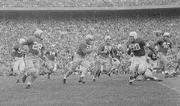To the thousands of Notre Dame fans taking the trip West
for the Irish football game with the Nebraska Cornhuskers,
it wasn’t enough that their team was defending their
National Championship from the prior year and currently
sported a number 2 ranking in the nation. The fans knew they
had Nebraska right where they wanted them. During the
1920’s the Irish would often find themselves among the
nation’s elite, only to be upset by a rag-tag group of
Cornhusker players and feel the sting of their barbs. This
year they knew would be different. Last season the two
schools had renewed a dormant rivalry and the Irish
prevailed by a large margin. There was little evidence that
this year’s game would be any different.
By most measures, the Husker team of 1948 was not one to
be feared by many programs. Losing seasons had become the
norm and, save for center Tom Novak who would go on to earn
All-American honors that year.
Over Thirty-seven thousand fans filled Memorial Stadium
expecting to see a display of dominance from one of the
country’s best teams, or an upset of momentous
proportions. They found the former would be the order of the
day. Notre Dame was a prohibitive 40-point favorite, despite
the fact that stars Coy McGee and Bill Fischer would miss
the game with injuries.
Not willing to let Nebraska get an early foothold, as
they had in previous matches, Notre Dame pulled out all
their guns and fired early on the Huskers. An opening period
Notre Dame drive of 80-yards was punctuated by an eight-yard
Emil Sirko run for a touchdown a mere four minutes into the
game. The Irish struck again in the first behind a dazzling
73-yard touchdown run by fullback John Panelli. Suddenly
Notre Dame was sporting a 13-0 lead and the prospects of an
upset looked bleak for the Cornhuskers.
The second period found Notre Dame keeping up with their
game plan of lightning quick runs and crushing pass plays.
Frank Spaniel turned in runs of 32 and 12 yards set up the
Irish’s third score. Quarterback Frank Tripuka tossed a
29-yarder to Bill Wightkin in the corner of the end zone for
the touchdown.
Nebraska finally got a short-lived gasp of breath later
in the second period. With the Irish driving again, Sitko
fumbled the ball and Don Sailors recovered it for the red.
The Husker hopes were quickly dashed when Junior Callopy
intercepted the ball back for the Irish at the NU 26. It
only took a few plays before Jack Landry took the ball in
for another Irish score.
Hope sprung forth again for the Huskers near the end of
the half when Sailors recovered another Irish miscue at
Notre Dame 22 with 30 seconds remaining. Captain Cletus
Fischer provided the needed yards to score one for the
Huskers and made the score 25-7 at the break.
Things continued to get further out of hand in the third
period. Notre Dame scored twice more in the stanza and
seemed to be able to move the ball at will. Meanwhile
Nebraska was thwarted at each turn.
Notre Dame scored once more in the fourth quarter for
good measure. Nebraska was able to end things on a high note
when the Irish fumbled at their own 2 yard line as time was
winding down. Fischer dove in from there to at least move
the Huskers' final score total into double-digits. Even so,
from the opening gun there was little doubt who the superior
team on the field was.
The game’s box score reflected the results on the
scoreboard. Notre Dame turned in an impressive 528 yards of
rushing while the Huskers managed just 111 of their own.
Notre Dame added another 93 yards of passing to their
totals.
Nebraska’s fortunes didn’t improve much through the
rest of the 1948 season. Losses to Kansas, UCLA, Oklahoma,
Missouri and Oregon State kept the gloom over Memorial
Stadium for the Winter. Before the next year would begin,
head coach "Potsy" Clark would be gone and Bill
Glassford would arrive bringing hopes of a revival for a
once dominate Husker squad. The true revival for the team
was still a little over a decade away.

![]()


